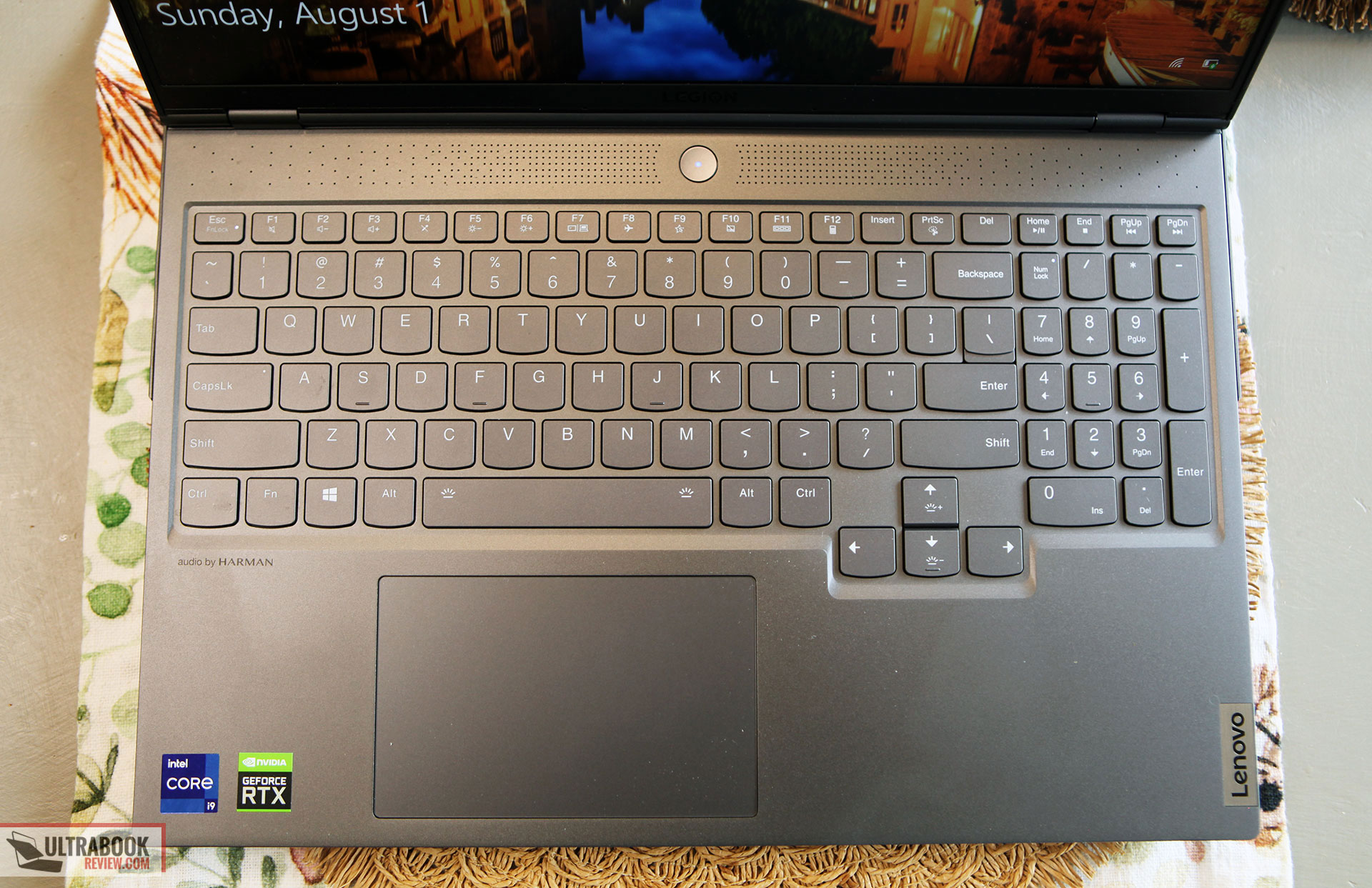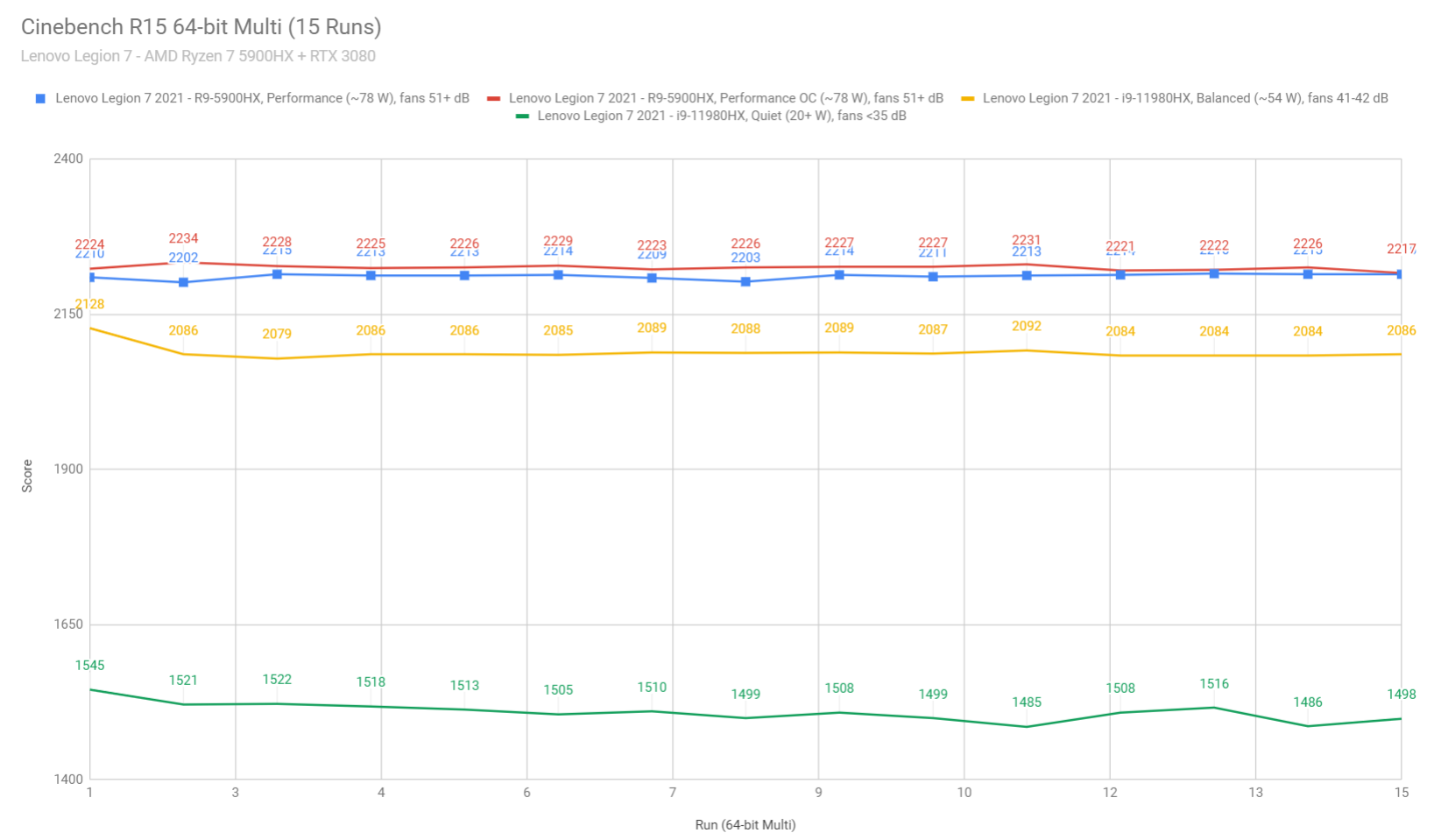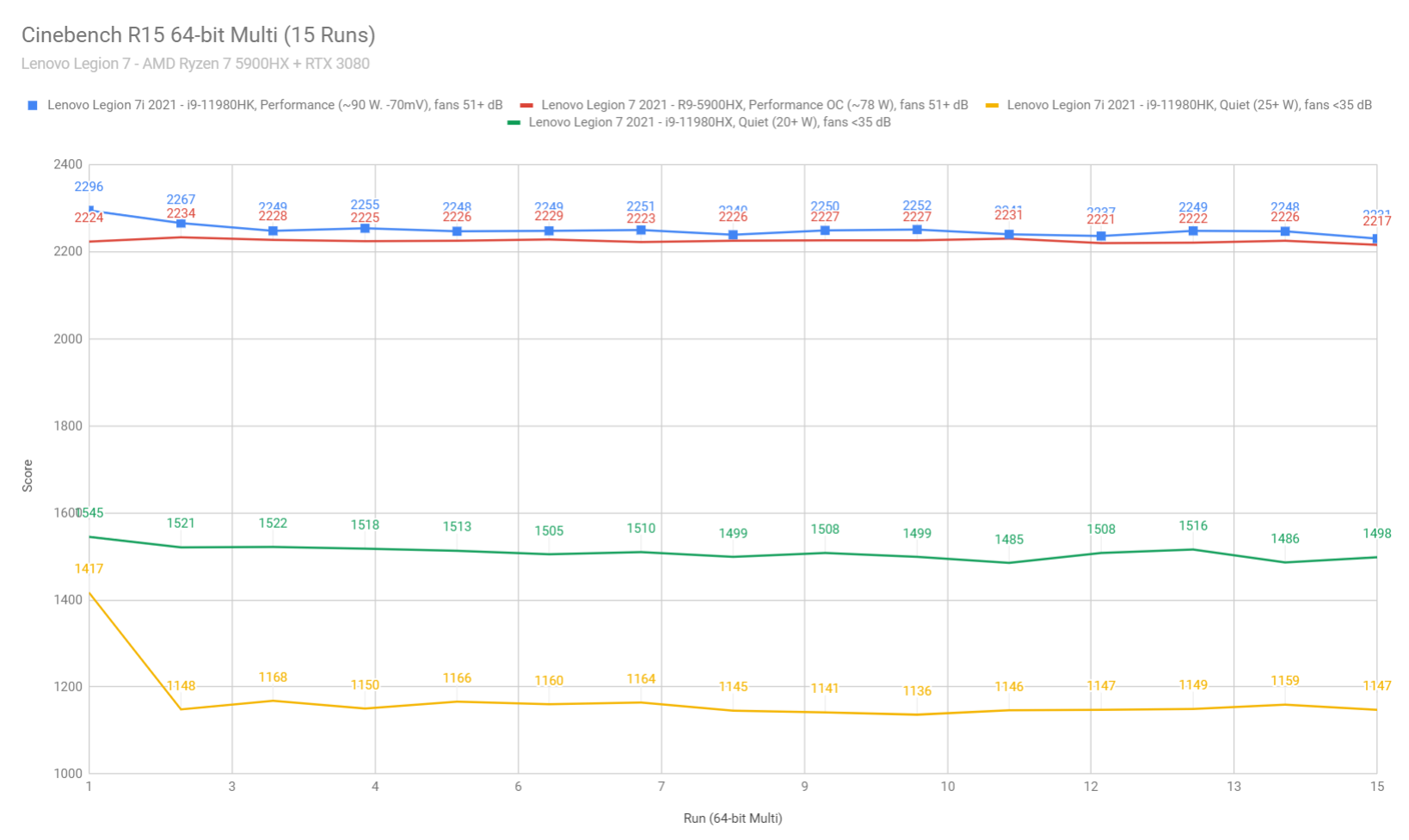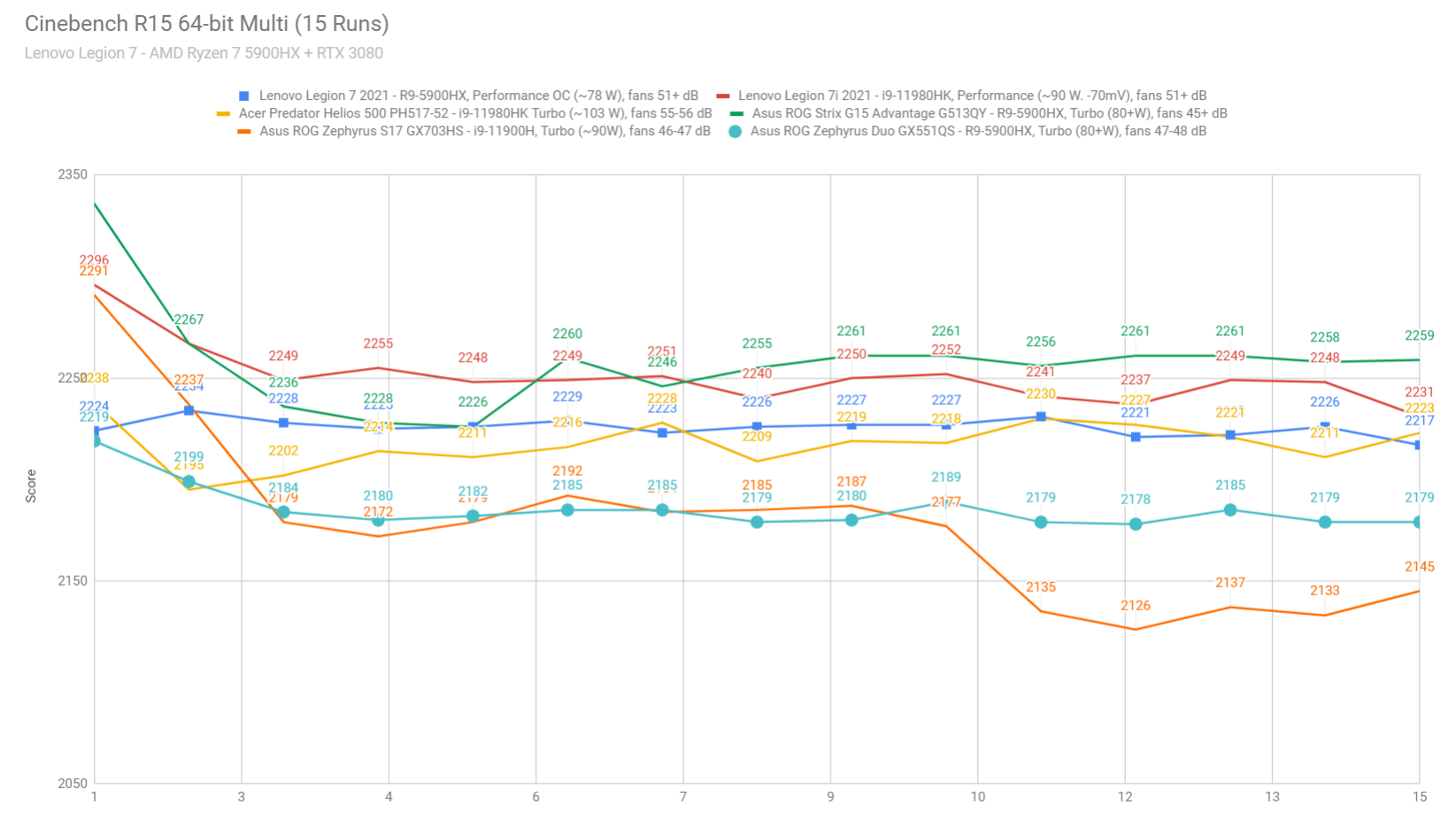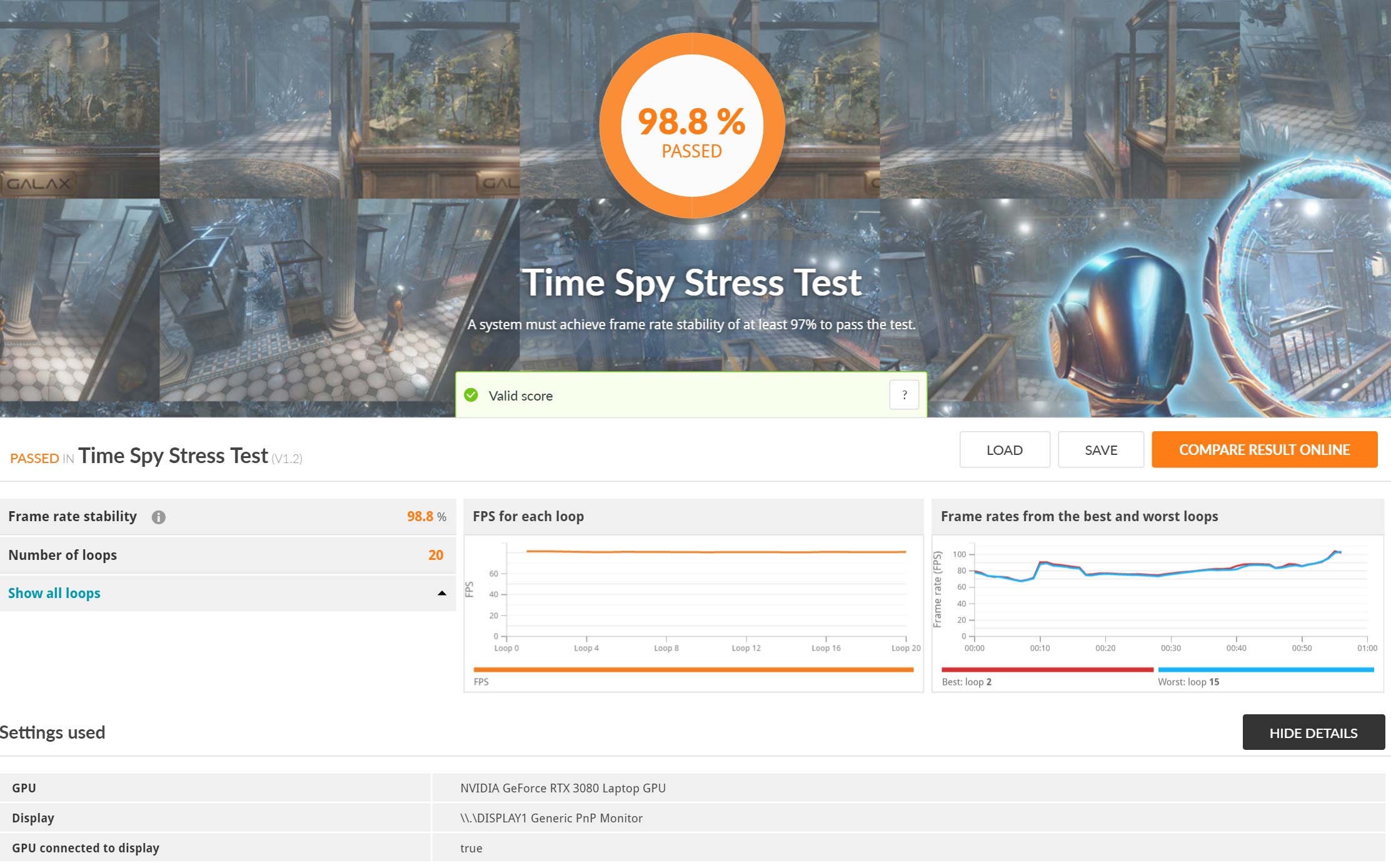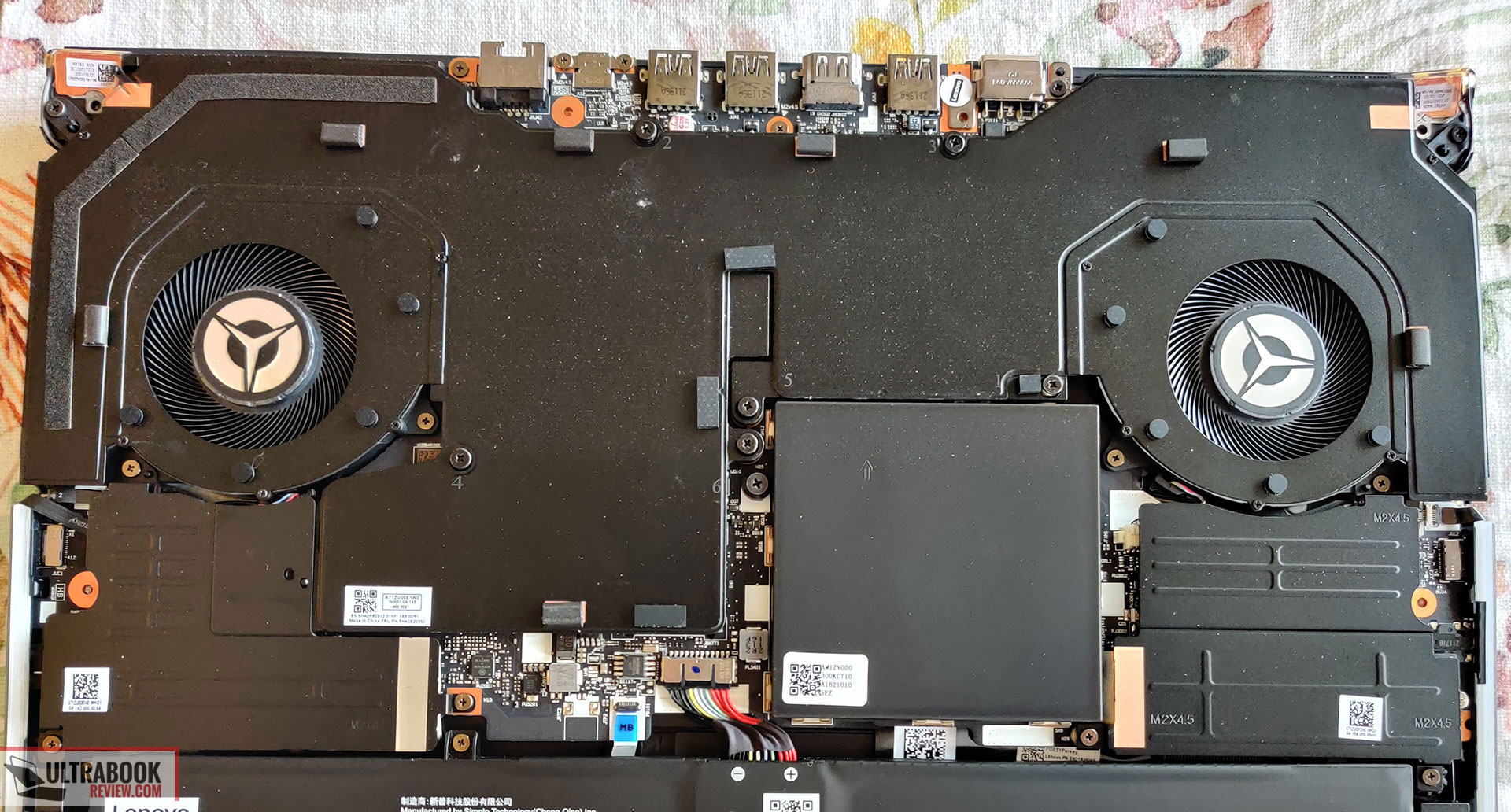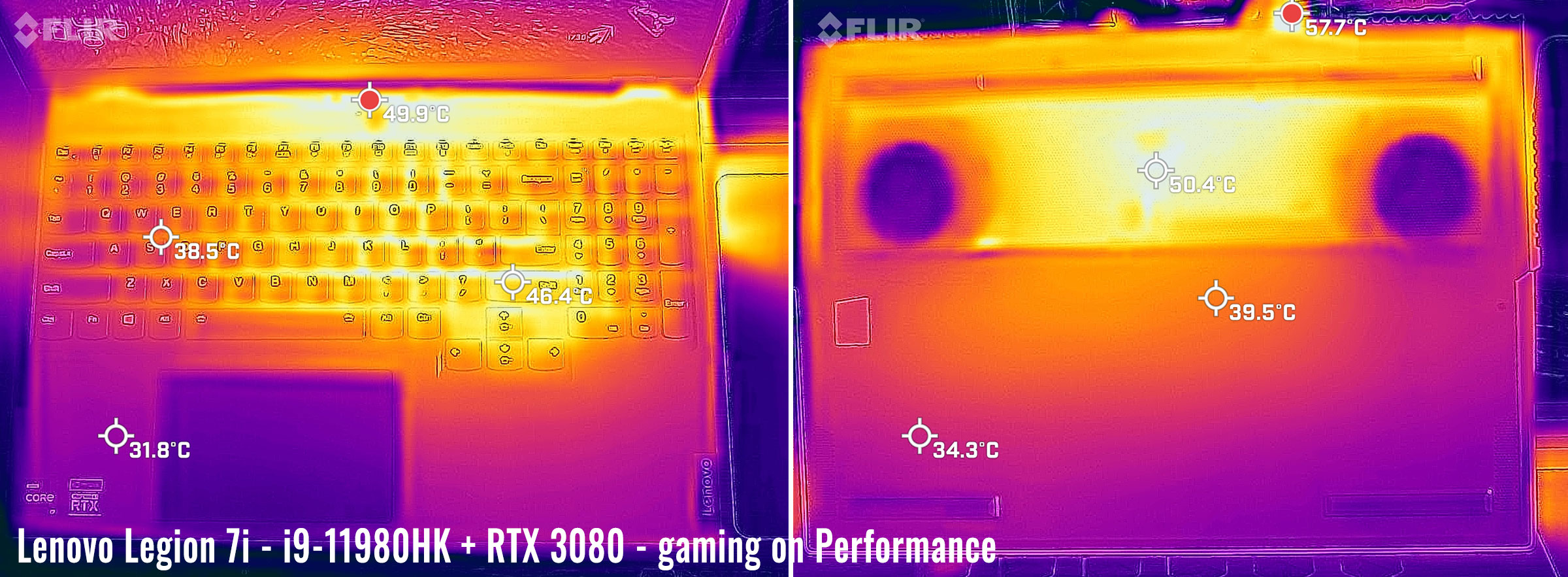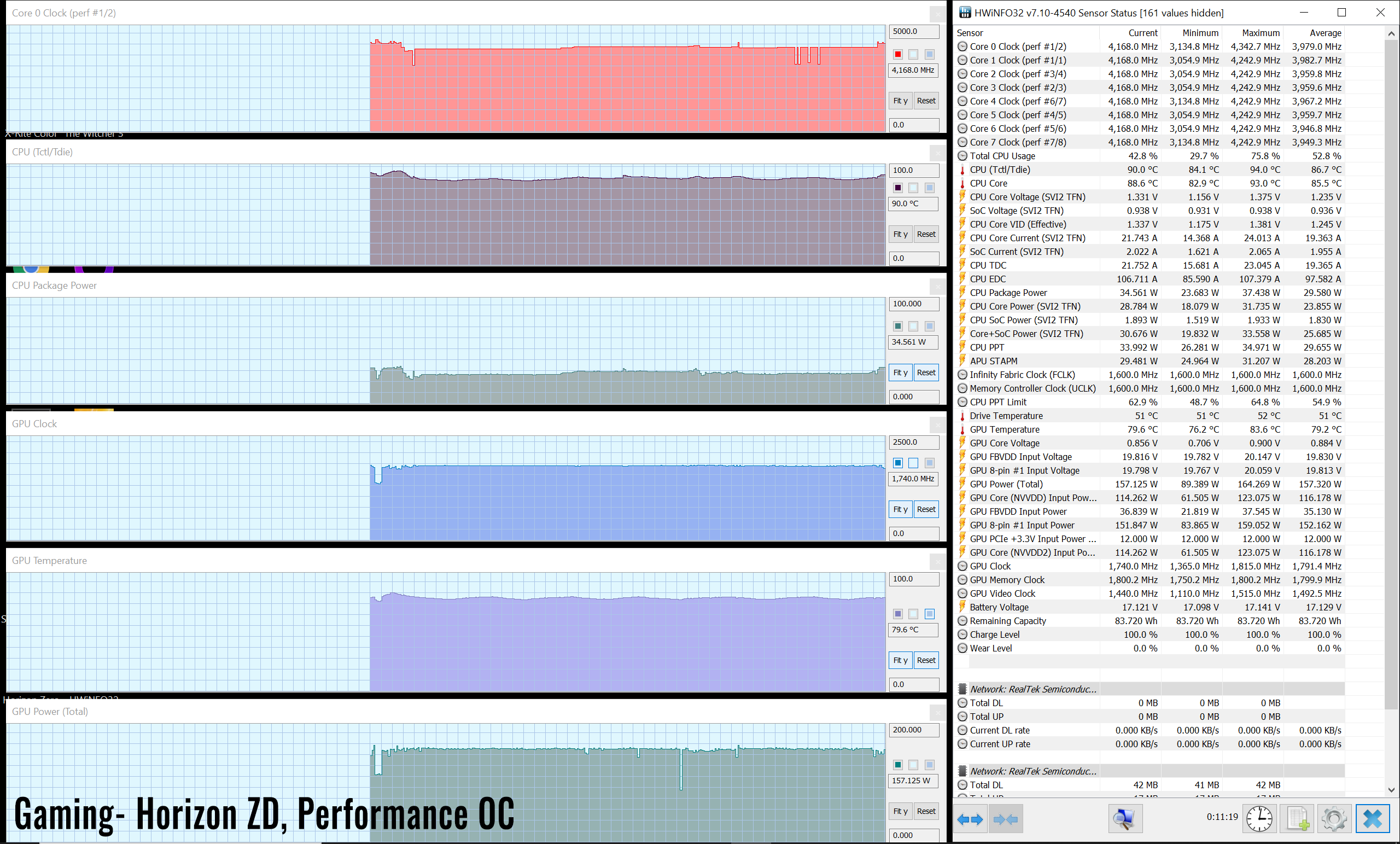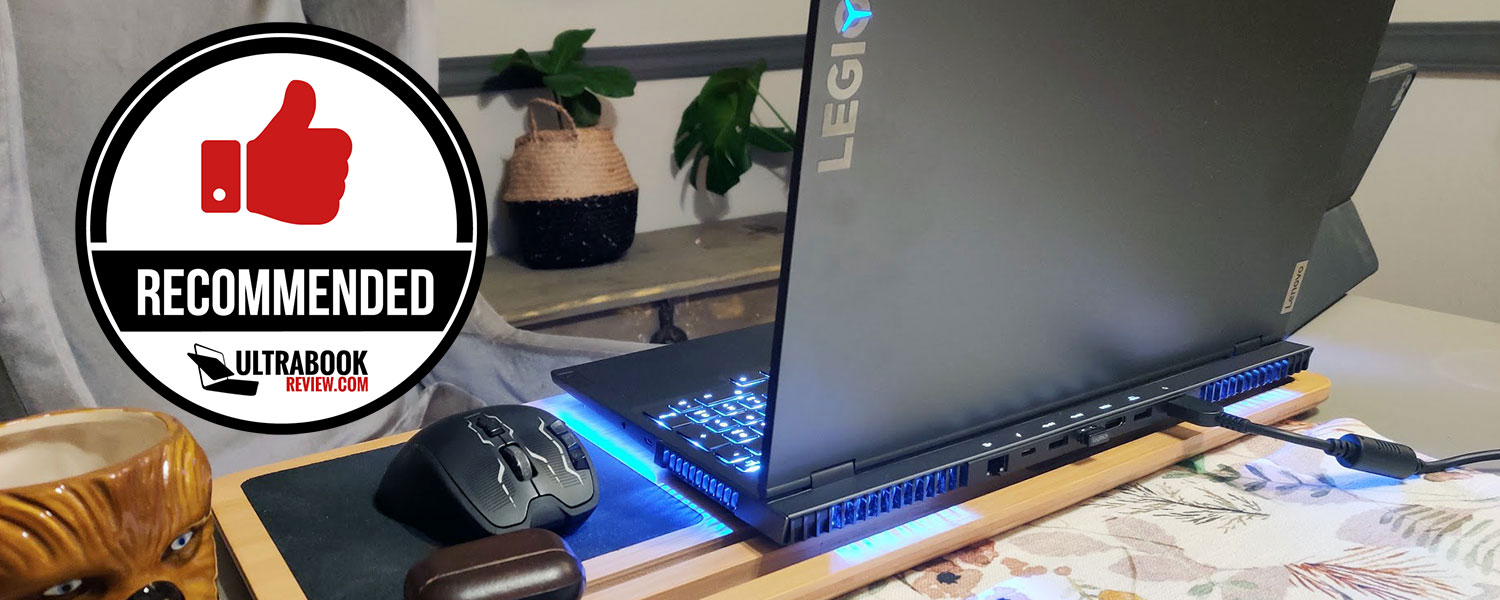Lenovo Legion 7 AMD-version review (Ryzen 9, RTX 3080), vs Intel i9 model
You might have already read my Lenovo Legion 7i article, which includes the top-specced Intel Core i9 CPU paired with the RTX 3080 graphics chip. But what about the AMD Ryzen version of the Legion 7?
Well, I got my hands on one and was able to put together a quick article on what the key differences are between the two hardware variants, and my recommendation them.
In short, I don’t think you could go wrong with either. But if it were me, I’d lean towards the AMD model, based solely on the battery testing results. However, the Intel model also has a couple of advantages that should be carefully considered before choosing between the two, which might matter especially if you don’t plan to use the laptop unplugged that often.
So the following article is going to be a little lighter than what I normally do. It’s going to refer to the Legion 7i article a lot, and will be mostly a “what’s different” approach rather than a full review.
Specs sheet as reviewed– Lenovo Legion 7 2021
| 2021 Lenovo Legion 7 16ACHG5 | |
| Screen | 16 inch, 2560 x 1600 px, IPS equivalent, 165 Hz, matte, 3ms |
| Processor | Ryzen 9 5900HX, 8C 16T (3.3Ghz with 4.6Ghz boost), 16MB Cache |
| Video | NVIDIA GeForce RTX 3080with 16GB GDDR6 VRAM 115-165W with Gsync and MUX, but no Advanced Optimus |
| Memory | 32 GB DDR4-3200 (2x16GB DIMMS) |
| Storage | 1 TB M.2 PCIe 3.0 + 1 empty slot |
| Connectivity | Realtek RTL8852ae Wi-Fi 6 with Bluetooth 5.2, Realtek Gigabit LAN |
| Ports | 2x USB-C 3.2 gen 2 with DP 1.4(left and rear, with reas supporting PD), 1x USB-C 3.2(right), 3x USB-A 3.2, ethernet, HDMI 2.1 |
| Battery | 80Whr, 300 W charger |
| Size | 360 mm or 14.17” (w) x 260 mm or 10.23” (d) x 20.1-23.5 mm or .79-.92” (h) |
| Weight | 2.5 kg (5.5 lbs) + 1.14 kg (2.5 lbs) power brick and cables, US version |
| Extras | Per key RGB keyboard, HD webcam with kill switch, stereo speakers, headphone/mic combo |
Design and first look
There’s really nothing to discuss about the design and construction of the Legion 7, if you’ve already read my Legion 7i article. It’s exactly the same in every way, except there’s a Ryzen sticker instead of an Intel one. I didn’t take new pictures for this article, so I’m still using the 7i pictures for illustration here, that’s why there’s the Core sticker in these images below.
There are, however, some key differences in the IO, but unless you need Thunderbolt 4, they’re minor. The USB-Cs on the rear and left of this laptop don’t support Thunderbolt like the ones on the Intel version do. They do support data, charging and DisplayPort 1.4, so you should still be able to connect displays if that’s your need.
I look at this as a minor difference, but others who actually need Thunderbolt will probably disagree. That said, most people who need Thunderbolt are not even considering Ryzen options, as they rarely support it. Other than that though, the IO is identical to the Legion 7i, which is fine by me.
Keyboard and trackpad
There’s nothing to talk about here either – the keyboard and trackpad are exactly the same as the Legion 7i I reviewed last month. Even the keys that had a little extra light bleed that most of the others were the same as on this one.
Unfortunately, things being the same also means the iCUE keyboard software still causes extreme battery drain, making it difficult to recommend keeping on. I will reiterate what a reader mentioned in the previous article, though. There is a way to use the iCUE service without completely killing your battery life.
By making a .bat file with the following text, I was able to load a static per-key RGB setting that I desired and then run that batch file to kill the process. This, in result, prevents the severe battery drain that the iCUE service causes, but still allows me to have custom colors that are not the default ones baked into the firmware. Here’s the .bat contents:
—
@ECHO OFF
REM Terminate the iCUE software process if running
taskkill /IM “iCUE.EXE” /F
REM Stop the three Corsair services if running (the first process requires admin mode to stop, the other two do not)
net stop “Corsair Gaming Audio Configuration Service” /y
net stop “Corsair LLA Service” /y
net stop “Corsair Service” /y
—
Screen
The screen is also identical to the one in the Legion 7i. I did a quick calibration with DisplayCAL and the results were very similar, so I didn’t bother doing a complete analysis. It’s safe to say all the screens will have a little variation.
Down below I include the measurements taken on the Legion 7i for this BOE QHD 165Hz panel:
- Panel Hardware ID: BOE NE160QDM-NY1
- Coverage: 97% sRGB, 68.8% AdobeRGB, 70.8% DCI-P3;
- Measured gamma: 2.2;
- Max brightness in the middle of the screen: 530cd/m2 on power;
- Contrast at max brightness: 1293:1
- Native white point: 7040K;
- Black on max brightness: .41cd/m2.
There was one interesting feature that the Ryzen model had though and the Intel version didn’t. Fn-R actually works on this model, which quickly switches the refresh rate from 165Hz to 60Hz when needed. This was a great way to quickly improve battery life while using the laptop away from power.
That aside, I will also mention that this model doesn’t support Advanced Optimus as the Intel model does. So GSYNC is only supported if you switch to Discrete graphics in Lenovo Vantage, by unchecking Hybrid mode.
With Hybrid mode enabled, the laptop uses regular Optimus, which supports FreeSync. But in this mode the graphics are passed through the iGPU on their way to the laptop’s main display, so your performance will be slightly lower in some loads and games.
Hardware and performance
Like the Legion 7i, I have the top-spec model of the Lenovo Legion 7. This includes Ryzen’s best available CPU, the AMD Ryzen 9 5900HX, which is an octa-core processor capable of putting out up to 4.6GHz per core. It’s not quite as powerful as the i9-11980HK, but it’s pretty close. It also uses far less power at full load. More on that soon.
Also included in this model is an Nvidia RTX 3080 GPU, with 16GB of VRAM. Like I mentioned in the other article, the extra VRAM is appropriate, considering the 165Hz QHD+ screen. This GPU is also able to use 165W with Dynamic boost, which is awesome.
The Ryzen model also has 32GB of DDR4 3200Mhz RAM, with two 16GB DIMMS. They are Samsung on this model but are still 1Rx8, meaning they are the slower-latency single ranked kind.
In the Intel version, I swapped out the RAM and wasn’t able to tell much of a difference in performance. I originally thought that perhaps just the Ryzen version was more susceptible to the effects of single-ranked RAM. I’ll get into the details soon, but it’s the same case with this model – the RAM is fine as is (at least for the 32GB models).
The last hardware item to cover is the SSD, which also happens to be the only difference between models. This model has a Western Digital 1TB SSD which is PCIe gen 3 instead of the gen 4 Samsung drives on the Intel version. This is because the Ryzen laptops do not support PCIe Gen 4 SSDs.
I honestly don’t see this as a major difference, as most people don’t *need* that kind of SSD speed. But it’s something you need to think about if you plan on using this laptop for something like content creation, where batch processing might be more of a thing.
Lenovo Legion 7 – benchmarks and performance
Onto the benchmarks.
The Legion 7 is preinstalled with Lenovo Vantage. The software is used for a number of different things, but one of the uses is to adjust the CPU/GPU power settings.
The three available modes are Performance, Balanced and Quiet. You can also switch between these modes with Fn-Q. The power button even has a different color that tells you what mode you’re in. Here’s a table that shows what each mode does:
| Quiet (blue) |
Balanced (white) |
Performance (red) |
Battery | ||||
| TDP PL1/PL2 | TGP | TDP PL1/PL2 | TGP | TDP PL1/PL2 | TGP | TDP PL1/PL2 | TGP |
| 20/30W | 115W | 54W/65W | 115W | 78W/85W | 150-165W | 25/37W | 30-40W |
This is one of the areas where the Ryzen and Intel models differ. The Quiet profile is the most significant difference, as the Intel model allows for up to 45W on the CPU in this case, while the Ryzen model is only up to 30W. This plays a huge part in CPU performance while gaming, which you’ll see more below.
In fact, all of the 5900HX CPU power profiles are lower wattage in comparison to the i9-11980HK. But the Ryzen CPU is clearly more efficient, as the actual performance is somewhat similar at those higher powers, and better at low power. Our Cinebench R15 loop test stands as proof, and here’s how the Legion 7 scores on the 4 different power profiles.
And here’s how the Intel and AMD models fare in comparison, on Performance and Quiet. Despite the fact that the Intel model runs at higher power at max and allows for undervolting, the performance is within 1-2% between the two, and that’s because the i9-11980HK cannot run at its full Turbo Boost all-core speeds at 90W on the Legion 7i, but the Ryzen 9 5900HX can run at its maximum potential on the Legion 7 at 78W. Of course, the maximum potential of the R9 is lower than that of the i9, and hence the tie between the two implementations.
On the other hand, on Quiet, the AMD model is 25-30% faster than the Intel variant, while also running at 20% less power.
Finally, here’s how this Ryzen 9 5900HX implementation compares to other same-tier models on the market, both Intel and AMD. This is a solid Ryzen 9 implementation here and only outmatched on the AMD side by the higher-power R9 in the ROG G15 Advantage.
We also ran our combined CPU+GPU stress tests on this notebook. 3DMark stress runs the same test for 20 times in a loop and looks for performance variation and degradation over time, and this unit passed it fine, which suggests there are no significant performance losses that might be caused by thermal throttling on this laptop. We got the exact same result on the Intel configuration.
I did a number of synthetic benchmarks on this laptop. This is going to be a little different than I normally do it since I’m going to be comparing it to the Intel Legion 7i as well.
For my first run, I set Lenovo Vantage to Performance mode:
| Performance mode | Legion 7 (AMD Ryzen 9) | Legion 7i (Intel Core i9) |
| 3DMark 13 – Fire Strike | 25793 (Graphics – 29683, Physics – 25864) | 23795 (Graphics – 31049, Physics – 26120) |
| 3DMark 13 – Time Spy | 11982 (Graphics – 12373, CPU – 10167) | 11677 (Graphics – 11820, CPU – 10930) |
| 3DMark 13 –CPU profile | max – 6829 16 – 6829, 8 – 5927, 4 – 3442, 2 – 1769, 1 -898 | max – 8209 16 – 8213, 8 – 5587, 4 – 3729, 2 – 1979, 1 -1004 |
| 3DMark 13 – Port Royal (RTX) Graphics | 7538 | 7446 |
| Uniengine Superposition – 1080p Extreme | 7692 | 7919 |
| Uniengine Superposition – 1080p Medium | 20095 | 22356 |
| GeekBench 5 | Single-Core: 1493, Multi-core: 8406 | Single-Core: 1667, Multi-core: 9836 |
| CineBench R15 | OpenGL 123.87 fps, CPU 2244 cb, CPU Single Core 236 cb | OpenGL 191.09 fps, CPU 2317 cb, CPU Single Core 246 cb |
| CineBench R23 | CPU 13577 pts, CPU Single Core 1452 pts | CPU 13859 pts, CPU Single Core 1625 pts |
The GPU performance is fairly similar between the two, with differences within the margin or error. The Intel model does have a slight edge in the CPU tests, though, both in multi-core and especially in single-core loads.
These are the results with Vantage set to Balanced, a mid-level profile with quieter fans and only slightly limited power settings:
| Balanced Mode | Legion 7 (AMD Ryzen 9) | Legion 7i (Intel Core i9) |
| 3DMark 13 – Fire Strike | 24391 (Graphics – 27165, Physics – 26015) | 22649 (Graphics – 28462, Physics – 26776) |
| 3DMark 13 – Time Spy | 10750 (Graphics – 10915, CPU – 9905) | 10592 (Graphics – 10615, CPU – 10469) |
| 3DMark 13 –CPU profile | max – 6526, 16 – 6587, 8 – 5757, 4 – 3450, 2 – 1767, 1 -901 | max – 7093, 16 – 7134, 8 – 5980, 4 – 3772, 2 – 1988, 1 -1017 |
| 3DMark 13 – Port Royal (RTX) Graphics | 6880 | 6758 |
| Uniengine Superposition – 1080p Extreme | 6868 | 7053 |
| Uniengine Superposition – 1080p Medium | 19800 | 20805 |
| GeekBench 5 | Single-Core: 1492, Multi-core: 8104 | Single-Core: 1674, Multi-core: 9419 |
| CineBench R15 | OpenGL 174.84 fps, CPU 2132 cb, CPU Single Core 234 cb | OpenGL 194.28 fps, CPU 2057 cb, CPU Single Core 245 cb |
| CineBench R23 | CPU 12747 pts, CPU Single Core 1437 pts | CPU 12418 pts, CPU Single Core 1623 pts |
And these are the results with Vantage set to Quiet mode:
| Quiet Mode | Legion 7 (AMD Ryzen 9) | Legion 7i (Intel Core i9) |
| 3DMark 13 – Fire Strike | 13336 (Graphics – 21521, Physics – 8899) | 19418 (Graphics – 27797, Physics – 18408) |
| 3DMark 13 – Time Spy | 9578 (Graphics – 9606, CPU – 9424) | 10094 (Graphics – 10794, CPU – 7384) |
| 3DMark 13 –CPU profile | max – 3363, 16 – 3468, 8 – 2786, 4 – 1923, 2 – 466, 1 -207 | max – 4788, 16 – 4377, 8 – 3627, 4 – 2546, 2 – 1606, 1 -967 |
| 3DMark 13 – Port Royal (RTX) Graphics | 6685 | 6728 |
| Uniengine Superposition – 1080p Extreme | 6524 | 6882 |
| Uniengine Superposition – 1080p Medium | 8339 | 19085 |
| GeekBench 5 | Single-Core: 368, Multi-core: 3844 | Single-Core: 1556, Multi-core: 6952 |
| CineBench R15 | OpenGL 44.8 fps, CPU 1529 cb, CPU Single Core 152 cb | OpenGL 134.96 fps, CPU 1281 cb, CPU Single Core 223 cb |
| CineBench R23 | CPU 10175 pts, CPU Single Core 312 pts | CPU 7531 pts, CPU Single Core 1534 pts |
In this case, the Intel model seems to run better across the board, with both the CPU and the GPU being way more aggressively capped on the AMD model. Perhaps too aggressively limited.
I then set the GPU OC to +100Mhz and the CPU OC to the default in the BIOS on both laptops, and retook some benchmarks in the Performance mode. Note that the i9 CPU is not overclockable in the BIOS so I only OC the GPU on that model:
| Performance mode, OC in BIOS | Legion 7 (AMD Ryzen 9) | Legion 7i (Intel Core i9) |
| 3DMark 13 – Fire Strike | 26465 (Graphics – 30616, Physics – 26233) | 25882 (Graphics – 32222, Physics – 25706) |
| 3DMark 13 – Time Spy | 12351 (Graphics – 12891, CPU – 9985) | 12601 (Graphics – 12825, CPU – 11468) |
| 3DMark 13 –CPU profile | max – 6849 16 – 6838, 8 – 5957, 4 – 3451, 2 – 1768, 1 -1017 | max – 8034 16 – 8023, 8 – 6168, 4 – 3760, 2 – 2001, 1 -1017 |
| 3DMark 13 – Port Royal (RTX) Graphics | 7813 | 7874 |
| Uniengine Superposition – 1080p Extreme | 7981 | 8007 |
| Uniengine Superposition – 1080p Medium | 21547 | 22569 |
| GeekBench 5 | Single-Core: 1506, Multi-core: 8466 | Not taken |
| CineBench R15 | OpenGL 134.24 fps, CPU 2146 cb, CPU Single Core 232 cb | Not taken |
| CineBench R23 | CPU 13530, CPU Single Core 1458 pts | Not taken |
Not a lot changes over the default Performance profile, but the GPU scores do improve by 2-7% in some of the tests.
Finally, here’s how things change (or didn’t change) when I swapped out the RAM for my 32GB RAM kit, on the Performance OC mode:
| Performance OC mode, with 32 GB RAM | Legion 7 (AMD Ryzen 9) | Legion 7i (Intel Core i9) |
| 3DMark 13 – Fire Strike | 26556 (Graphics – 30650, Physics – 26344) | 25350 (Graphics – 30928, Physics – 26496) |
| 3DMark 13 – Time Spy | 12331 (Graphics – 12844, CPU – 10059) | 12524 (Graphics – 12869, CPU – 10875) |
| 3DMark 13 –CPU profile | max – 6829 16 – 6822, 8 – 5953, 4 – 3442, 2 – 1760, 1 -897 | max – 8019 16 – 8033, 8 – 6196, 4 – 3741, 2 – 2001, 1 -1018 |
| 3DMark 13 – Port Royal (RTX) Graphics | 7820 | 7914 |
| Uniengine Superposition – 1080p Extreme | 8008 | 7907 |
| Uniengine Superposition – 1080p Medium | 21974 | 22383 |
| GeekBench 5 | Single-Core: 1510, Multi-core: 8435 | Single-Core: 1643, Multi-core: 9404 |
| CineBench R15 | OpenGL 168.76 fps, CPU 2209 cb, CPU Single Core 234 cb | OpenGL 237.60 fps, CPU 2276 cb, CPU Single Core 243 cb |
| CineBench R23 | CPU 13466 pts, CPU Single Core 1436 pts | CPU 13780 pts, CPU Single Core 1622 pts |
In short, excellent results in Performance mode, especially with the OC. There’s little reason not to OC, considering there’s no throttling either.
There are some differences in CPU performance between models. If you need the most CPU performance, the Intel model is clearly the better buy, as the scores were significantly higher across the board. But if you’re simply gaming, I don’t think you’ll notice as much of a difference.
GPU performance was pretty consistent between models, which is to be expected since the power limits are the same.
The last difference to mention is the result of the Quiet modes. CPU performance is so much worse for the Ryzen model in this mode. It’s definitely because of the lower power limit. The good news though is the fan noise is better than the Intel version in this mode.
Note that changing out the RAM had a negligible effect on the benchmarks, similar to the difference that was made on the Intel version. I originally thought that perhaps the Ryzen CPUs were affected by the cheaper RAM modules, but it appears that’s not the case. I do have a feeling that the 16GB models (2x 8GB) will suffer a decrease in performance, though, similar to what I experienced in the Legion 5 Pro.
Gaming on the Lenovo Legion 7
Now let’s talk about the gaming benchmarks. I did three sets of benchmarks this time: Performance mode, Quiet mode, and with the swapped-out RAM kit. Here’s what I got:
| QHD+ Performance w/ OC |
QHD+ Quiet w/ OC |
QHD+ Performance w/ OC and upgraded RAM |
|
| Battlefield V (DX 12, Ultra Preset, Ray-Tracing OFF) |
118 fps avg, 107 fps low | 99 fps avg, 94 fps low | 117 fps avg, 109 fps low |
| Battlefield V (DX 12, Ultra Preset, Ray-Tracing ON) |
62 fps avg, 52 fps low | 49 fps avg, 39 fps low | 60 fps avg, 54 fps low |
| The Witcher 3: Wild Hunt (DX 11, Ultra Preset, Hairworks On) |
88 fps avg, 83 fps low | 67 fps avg, 60 fps low | 87 fps avg, 83 fps low |
| The Witcher 3: Wild Hunt (DX 11, Ultra Preset, Hairworks Off) |
102 fps avg, 91 fps low | 85 fps avg, 81 fps low | 103 fps avg, 93 fps low |
| Horizon Zero Dawn (Ultra) |
91 fps avg, 85 fps low | 62 fps avg, 58 fps low | 92 fps avg, 85 fps low |
| Cyberpunk (Ultra, Ray Tracing On, DLSS Auto) |
60 fps avg, 55 fps low | 45 fps avg, 41 fps low | 60 fps avg, 56 fps low |
| Cyberpunk (Ultra, Ray Tracing On, DLSS off) |
31 fps avg, 28 fps low | 26 fps avg, 24fps low | 31 fps avg, 28 fps low |
| Cyberpunk (Ultra, Ray Tracing Off, DLSS off) |
52 fps avg, 48 fps low | 43 fps avg, 40 fps low | 52 fps avg, 48fps low |
| Valheim (Max Settings) |
86 fps avg, 75 fps low | 19 fps avg, 17 fps low | 86 fps avg, 76 fps low |
As you can see, the performance is excellent in Performance mode. Quiet mode is also pretty decent. And as mentioned, there were no significant advantages of using a different RAM kit.
Now let’s compare these results with the Intel version:
| Ryzen Legion 7 Performance w/ OC |
Intel Legion 7i Performance w/ OC |
Ryzen Legion 7 Quiet w/ OC |
Intel Legion 7i Quiet w/ OC |
|
| Battlefield V (DX 12, Ultra Preset, Ray-Tracing OFF) |
118 fps avg, 107 fps low | 123 fps avg, 115 fps low | 99 fps avg, 94 fps low | 110 fps avg, 101 fps low |
| Battlefield V (DX 12, Ultra Preset, Ray-Tracing ON) |
62 fps avg, 52 fps low | 54 fps avg, 49 fps low | 49 fps avg, 39 fps low | 47 fps avg, 43 fps low |
| The Witcher 3: Wild Hunt (DX 11, Ultra Preset, Hairworks On) |
88 fps avg, 83 fps low | 89 fps avg, 83 fps low | 67 fps avg, 60 fps low | 75 fps avg, 71 fps low |
| The Witcher 3: Wild Hunt (DX 11, Ultra Preset, Hairworks Off) |
102 fps avg, 91 fps low | 103 fps avg, 90 fps low | 85 fps avg, 81 fps low | 90 fps avg, 85 fps low |
| Horizon Zero Dawn (Ultra) |
91 fps avg, 85 fps low | 95 fps avg, 88 fps low | 62 fps avg, 58 fps low | 82 fps avg, 77 fps low |
| Cyberpunk (Ultra, Ray Tracing On, DLSS Auto) |
60 fps avg, 55 fps low | 58 fps avg, 55 fps low | 45 fps avg, 41 fps low | 52 fps avg, 49 fps low |
| Cyberpunk (Ultra, Ray Tracing On, DLSS off) |
31 fps avg, 28 fps low | 31 fps avg, 28 fps low | 26 fps avg, 24fps low | 27 fps avg, 25fps low |
| Cyberpunk (Ultra, Ray Tracing Off, DLSS off) |
52 fps avg, 48 fps low | 57 fps avg, 52 fps low | 43 fps avg, 40 fps low | 49 fps avg, 45 fps low |
| Valheim (Max Settings) |
86 fps avg, 75 fps low | 79 fps avg, 74 fps low | 19 fps avg, 17 fps low | 73 fps avg, 65 fps low |
As far as the Performance mode results go, I’ll go out on a limb and just call it a tie. Sure, there are slight differences, but keep in mind that these are actual gaming tests and while my scenarios are similar, it’s not an exact science like the synthetic benchmarks are.
But the Quiet mode results is where the major difference is, which is exactly to be expected considering the Ryzen’s TDP is so much lower. This is one of those areas where you will need to decide what is more important to you, if you’re struggling with what model to get.
Noise, Heat, Connectivity, speakers, and others
The thermals on the Legion 7 are exactly the same as on the Legion 7i.
In fact, besides actual internal temps of the components, the noise levels and external temps are almost exactly the same for day-to-day tasks, so I’ve included a thermal reading from the Intel model while running games on Performance, since this AMD variant is pretty much the same.
The internal temperatures slightly different though. I retook my Horizon Zero Dawn testing and jotted down the results. Take a look:
| Mode | Performance | Balanced | Quiet |
| CPU temps | 87C avg with 93C spike | 87C avg with 93C spike | 63C avg with 69C spike |
| GPU temps | 79C avg | 72C avg | 66C avg |
| Avg fan noise after stabilized temps | 54 dB | 42dB | 36dB |
| Game performance | 91 fps avg, 85 fps low | 83 fps avg, 80 fps low | 62 fps avg, 58 fps low |
For comparison sake, here were the results of the same test for the Legion 7i:
| Mode | Performance | Balanced | Quiet |
| CPU temps | 82C avg with 90C spike | 81C avg with 94C spike | 70C avg with 85C spike |
| GPU temps | 78C avg | 75C avg | 74C avg |
| Avg fan noise after stabilized temps | 52 dB | 42dB | 40dB |
| Game performance | 95 fps avg, 88 fps low | 85 fps avg, 80 fps low | 82 fps avg, 77 fps low |
So on this AMD model, the average CPU temperatures were a little higher in Performance and Balanced modes than on the Intel mode, but the CPU spikes were the same. Noise levels in Performance and Balanced modes were consistent across both models, as well.
The fan noise is much quieter in Quiet mode on the AMD version, but the performance is also a lot lower. Clearly, this is because of the TDP difference in the CPUs. Personal preference of fan noise/performance ratio at this point.
So this is the point where some will ultimately need to decide what they want in their machine, since there are some differences here. The Intel model is the better gamer in the Quiet mode, while the Ryzen laptop is actually quieter in Quiet mode, but less powerful.
My opinion? It probably won’t matter to most as I believe almost everyone is going to game in Performance or Balanced modes. And considering there’s a mere 2dB difference in Balanced vs Quiet on the Intel model, I see little point in even switching to Quiet mode on that one.
On the other hand, the Ryzen model’s Quiet mode is a significant reduction in fan noise, so perhaps those that really want “quiet” gaming would prefer the Ryzen model. You could argue it either way…
The last thing to talk about is Wifi and, oddly enough, the Wifi module is different for this AMD Legion 7 model. I have a Realtek RTL8852ae module, which is actually the same Wifi module that I had trouble with on the Legion 5 I reviewed last month. On the Legion 5, I actually swapped out the module for an Intel version because it died after a week of use.
I haven’t had any trouble with it on this model so far, though (fingers crossed). The Internet speed has been fine so far and I haven’t had any abnormal drops in connection yet. I’m not going to say I recommend it though, because many others online have had issues with this module, in many other models of laptops. I’m prepared to spend another $50 or so to buy a replacement, if and when the time comes.
The speakers and webcam are both identical to the Legion 7i, so please refer to that article for my opinions on both.
Battery life
This AMD Legion 7 has the same exact 80Whr battery as the Intel model. I just took a series of battery life tests with the brightness at 50%, which is about 120 nits, and running at the stock 165Hz refresh. Here were my results:
- 11.5 W (~6 h 57 min of use)– idle, Best Battery Mode, screen at 0%, Wi-Fi ON, backlighting off;
- 16.9 W (~4 h 44 min of use)– text editing in Word with light internet use, Better Battery Mode, screen at 50%, Wi-Fi ON;
- 16.4 W (~4 h 53 min of use)– 1440p 60Hz Youtube fullscreen in Chrome, Better Battery Mode, screen at 50%, Wi-Fi ON;
- 14.6 W (~5 h 29 min of use)– 1080p Netflix fullscreen video in Chrome, Better Battery Mode, screen at 50%, Wi-Fi ON;
- 24.8 W (~3 h 14 min of use)– heavy browsing in Chrome, Better Performance Mode, screen at 50%, Wi-Fi ON;
- 58.9 W (~1 h 22 min of use)– Gaming – Wither 3, Maximum Performance Mode, 60fps cap, screen at 50%, Wi-Fi ON.
And here are some battery results after hitting Fn-R, which switches refresh rate to 60Hz:
- 7.9 W (~10 h 7 min of use)– idle, Best Battery Mode, screen at 0%, Wi-Fi ON, backlighting off;
- 13.8 W (~5 h 48 min of use)– text editing in Word with light internet use, Better Battery Mode, screen at 50%, Wi-Fi ON;
- 5 W (~5 h 56 min of use)– 1440p 60Hz Youtube fullscreen in Chrome, Better Battery Mode, screen at 50%, Wi-Fi ON;
- 9 W (~7 h 43 min of use)– 1080p Netflix fullscreen video in Chrome, Better Battery Mode, screen at 50%, Wi-Fi ON;
- 5 W (~3 h 33 min of use)– heavy browsing in Chrome, Better Performance Mode, screen at 50%, Wi-Fi ON;
- 8 W (~1 h 20 min of use)– Gaming – Wither 3, Maximum Performance Mode, 60fps cap, screen at 50%, Wi-Fi ON.
Pretty decent results, especially setting the screen to 60Hz. In either refresh rate, there’s a definite improvement in battery life when you compare apples to apples against the Intel version. Clearly, the Ryzen CPU is more power-efficient and shaves a few watts or more off each scenario. If battery life is important to you, I highly recommend grabbing the Ryzen model.
The power brick is the same 300W brick and this unit also supports USB -C charging in the rear port, so no changes there.
Price and availability
There are still no listings on Amazon for the Legion 7 or the Legion 7i, but here’s a link that should find them when they pop up (at the time you’re reading the article).
In the meantime, the only way to purchase this laptop is on Lenovo’s website. You can make a custom build on their site, where you can choose between any of the CPU, GPU, and RAM options. Keep in mind though, the custom builds take time to make and eventually ship to you.
If you go that route, the model I have retails at $3009 which is $230 cheaper than the Intel model I also reviewed (but that one gets more and faster storage). Unless you’re in a rush though, I’d recommend waiting for a sale. Here’s why.
Lenovo seems to have sales on a monthly basis. They also restock “prebuilt” configurations, where they’ll have them in stock and ready to ship. When this happens, more times than not there’s a “doorbuster” or some other coupon code that takes a significant amount off the price tag.
In my case, the savings were insane. After the coupon, my price was $2320 for this AMD Legion 7 model. I was also able to click through my favorite cashback website for an additional $140 back. Crazy, I know. Deals THAT good aren’t as frequent, but if you’re patient and use an email alert on some of the deal websites, you’re bound to get something.
Final thoughts on the 2021 Lenovo Legion 7 with AMD Ryzen hardware
If prices were equal, I don’t think you could go wrong with either version of the Legion 7: Intel or Ryzen. But prices are not equal, as the Intel version is at least $230 higher than the Ryzen version with similar specs, and most likely even more expensive with the applied discounts.
There are some reasons to justify the Intel price gap, though. For starters, the Intel version has Thunderbolt support while the Ryzen model doesn’t. The Intel version also supports gen 4 SSDs, which are faster than the gen3s in the Ryzen model, and actually ships with these type of faster storage drives. In fact, the Intel model comes with TWO gen 4 SSDs, which are significantly faster than the single gen 3 SSD in this Ryzen unit. That alone makes up for $100-150 of the price difference.
So if that’s enough of a justification for the price gap, the only thing left is to decide which model is more suited for your needs. And the only two major differences left are CPU performance and battery life.
If you need the most CPU power you can get, the Intel model is clearly the better buy here. The performance bump is anywhere between 10-20% higher, depending on the benchmark and the number of cores you’re using.
But the Ryzen model offers way better battery life. So if you plan to use your laptop unplugged a lot, I can’t say enough how badly you should consider the Ryzen model over the Intel model.
The final thing I’ll mention is Advanced Optimus. This is absent in the Ryzen model, but I’ll be frank with you, you don’t need it. It was a little buggy on my Intel unit anyway, as it caused some major stuttering on some games and ultimately just got turned off. And at that point, the other choice is manually switching between Optimus and dedicated graphics, just like in the Ryzen model.
Hope this helps you guys make an informed decision on these 2021 Lenovo Legion 7 and 7i laptops. I think I’ve covered all the differences, but if you still have questions, please let me know below.
